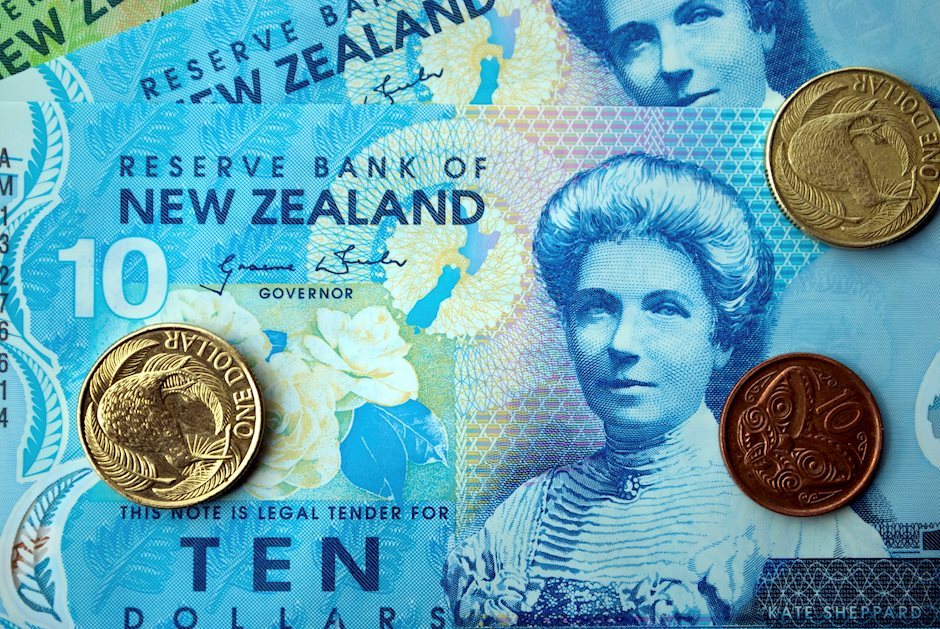NZD/USD extends decline to near 0.5900 due to risk-off mood
- NZD/USD loses ground due to the increased risk aversion amid fears of an economic slowdown in the US.
- CME FedWatch tool indicates a 74.5% probability of a 50-basis point rate cut by the Fed in September.
- RBNZ is partly expected to deliver an early interest rate cut in August and fully expect one by October.

NZD/USD extends its losses for the second successive day, trading around 0.5930 during the European session on Tuesday. Growing Middle East tensions and fears of an economic slowdown in the United States (US) have dampened the appeal of risk-sensitive currencies like the New Zealand Dollar (NZD).
However, the downside of the NZD/USD pair could be limited as the US Dollar (USD) could struggle due to the expectation of a 50-basis point (bps) interest rate cut by the US Federal Reserve (Fed) in September. The CME FedWatch tool indicates a 74.5% probability of this relatively larger cut occurring at the September meeting, a significant increase from the 11.4% chance reported a week earlier.
According to Reuters, Federal Reserve Bank of San Francisco President Mary Daly expressed increased confidence on Monday that US inflation is moving towards the Fed's 2% target. Daly noted that “risks to the Fed's mandates are becoming more balanced and that there is openness to the possibility of cutting rates in upcoming meetings.”
In New Zealand, expectations of an early interest rate cut by the Reserve Bank of New Zealand (RBNZ) are putting pressure on the Kiwi Dollar, affecting the NZD/USD pair. This sentiment follows recent data indicating that the domestic annual CPI rate fell to its lowest level in three years for the June quarter. The RBNZ's next policy meeting is scheduled for August 14, with markets partly anticipating a rate cut at that meeting and fully expecting one by October.
Traders will likely monitor the release of China’s July Consumer Price Index (CPI) on Friday for new momentum. The CPI is expected to show a 0.4% year-on-year increase. A weaker-than-expected reading or signs of an economic slowdown in China could impact the New Zealand Dollar, given China’s close trading relationship with New Zealand.
New Zealand Dollar FAQs
The New Zealand Dollar (NZD), also known as the Kiwi, is a well-known traded currency among investors. Its value is broadly determined by the health of the New Zealand economy and the country’s central bank policy. Still, there are some unique particularities that also can make NZD move. The performance of the Chinese economy tends to move the Kiwi because China is New Zealand’s biggest trading partner. Bad news for the Chinese economy likely means less New Zealand exports to the country, hitting the economy and thus its currency. Another factor moving NZD is dairy prices as the dairy industry is New Zealand’s main export. High dairy prices boost export income, contributing positively to the economy and thus to the NZD.
The Reserve Bank of New Zealand (RBNZ) aims to achieve and maintain an inflation rate between 1% and 3% over the medium term, with a focus to keep it near the 2% mid-point. To this end, the bank sets an appropriate level of interest rates. When inflation is too high, the RBNZ will increase interest rates to cool the economy, but the move will also make bond yields higher, increasing investors’ appeal to invest in the country and thus boosting NZD. On the contrary, lower interest rates tend to weaken NZD. The so-called rate differential, or how rates in New Zealand are or are expected to be compared to the ones set by the US Federal Reserve, can also play a key role in moving the NZD/USD pair.
Macroeconomic data releases in New Zealand are key to assess the state of the economy and can impact the New Zealand Dollar’s (NZD) valuation. A strong economy, based on high economic growth, low unemployment and high confidence is good for NZD. High economic growth attracts foreign investment and may encourage the Reserve Bank of New Zealand to increase interest rates, if this economic strength comes together with elevated inflation. Conversely, if economic data is weak, NZD is likely to depreciate.
The New Zealand Dollar (NZD) tends to strengthen during risk-on periods, or when investors perceive that broader market risks are low and are optimistic about growth. This tends to lead to a more favorable outlook for commodities and so-called ‘commodity currencies’ such as the Kiwi. Conversely, NZD tends to weaken at times of market turbulence or economic uncertainty as investors tend to sell higher-risk assets and flee to the more-stable safe havens.
Author

Akhtar Faruqui
FXStreet
Akhtar Faruqui is a Forex Analyst based in New Delhi, India. With a keen eye for market trends and a passion for dissecting complex financial dynamics, he is dedicated to delivering accurate and insightful Forex news and analysis.

















